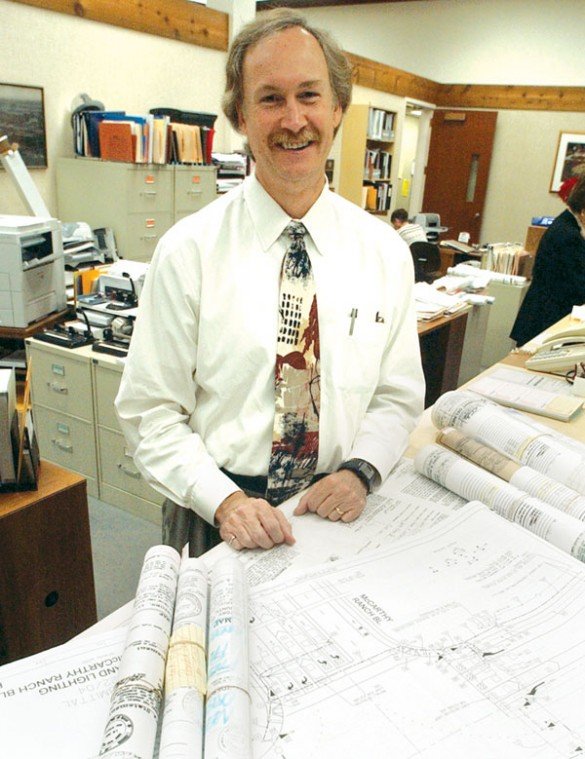Gilroy
– Don Dey knows that his profession involves as much diplomacy
as science.
After 25 years as a traffic engineer, Dey, who started as City
Transportation Engineer in March, is currently managing some of the
largest projects in town, including the widening of Santa Teresa
Boulevard to the west and, to the east, planning for a bridge and
road extension along Camino Arroyo.
Gilroy – Don Dey knows that his profession involves as much diplomacy as science.
After 25 years as a traffic engineer, Dey, who started as City Transportation Engineer in March, is currently managing some of the largest projects in town, including the widening of Santa Teresa Boulevard to the west and, to the east, planning for a bridge and road extension along Camino Arroyo. That project will create a direct connection between the outlet centers and the big box stores south of Sixth Street, something many residents worry will increase traffic along the road.
Between delayed motorists, parents worried about kids returning from school, and businesses anxious for direct access roads, Dey acknowledged that it is not easy to keep everyone happy.
“There are competing perspectives,” he said, naming residents, pedestrians, bicyclists and motorists as just a few of the stakeholders in any project.
“How do you balance those so that all are best served?” he asked. “There’s generally not one best answer, so there’s a diplomatic aspect to this. It’s not like designing a bridge – it’s dealing with individuals.”
“That’s why it’s called the ‘soft part’ of engineering,” Dey said.
Traffic engineers focus on road design, the placement of signals, markers, and other ways of controlling traffic flow, he explained. Transportation engineers are responsible for a broader range of activities, including long-range road planning, assessing a project’s environmental effects and applying for grants. Dey serves in both capacities for Gilroy, performing the day-to-day review of construction plans and handling the traffic and circulation elements of major projects.
Dey ranked downtown Gilroy as one of the city’s biggest traffic challenges. The area is on the verge of a major growth spurt that will bring a new arts center, dozens of business, and hundreds of homes in the next few years.
The growth of the downtown area will force the city to carefully balance the needs of pedestrians and vehicles, according to Dey. Traffic circulation, parking, and sidewalk design are just a few considerations.
“You need to come up with a design that is a compromise of all things,” Dey said. “Otherwise, one side will suffer at the expense of the other.”
Although he has spent his entire adult life as a traffic engineer, Dey admits he happened on the career somewhat by chance. As a teenager, he said he had little interest in college.
“I worked for a few years after high school,” he said, “but after living that way for a while, I found I didn’t enjoy the jobs I was able to get.”
He eventually went down to the local YMCA in his native Toronto, Canada, and took a couple of job-personality tests.
“It turned out that I’d be good at either computer programming or engineering,” he recalled. He decided to choose the latter since it combined both, enrolling in a five-year cooperative program at the University of Waterloo – not far from Toronto. As part of the program, he alternated between four months of study and four months of hands-on work at area companies.
“It helped identify what I was interested in because civil engineering is a very broad field,” he explained.
A structural engineer, for instance, is responsible for the construction of bridges and buildings, whereas a traffic engineer looks at the movement of cars, bikes, buses, all the different ways people get around, according to Dey. He said traffic engineers supply structural engineers with field work and research so “they [can] determine how much concrete and steel is needed.”
After graduating from college, he worked in Houston for a year as a traffic consultant, followed by five years with the City of Garland, a Dallas suburb, as a transportation engineer. From there he moved to positions in Anaheim and Menlo Park, fitting in a two-and-a-half year consulting stint in Arizona before returning to California for a job in Long Beach.
He said he chose engineering in part because it allows him and his wife the freedom to move. That wanderlust eventually led Dey to Gilroy.
And while Gilroy residents may disagree with him about the pros and cons of any given project, Dey said one simple truth seems to hold true wherever he goes.
“If a city isn’t doing well, then they wouldn’t need a traffic engineer,” he said. “As a city grows, then we come into play.”













